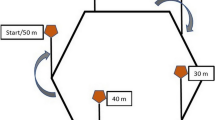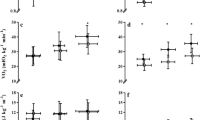Abstract
Purpose
Cycling underwater is a low impact physical activity that has became popular workout due to capability to enhance physical fitness. The aim of this study was to determine the relationship between pedal cadence with heart rate (HR) and oxygen uptake (VO2) during incremental exercise test in a novel adjustable resistance bike underwater.
Methods
Fifteen participants completed three incremental cycling tests in a random order. Each test began at 50 revolutions per minute (RPM) and increased 3 RPM every minute until volitional exhaustion. The bike has the unique ability to manipulate the frontal surface area (FSA) of the blades providing three different resistance settings for the same RPM (FSA1 = 500 cm2, FSA2 = 580 cm2, and FSA3 = 660 cm2).
Results
The findings indicated a strong linear relationship between RPM vs. %VO2peak and RPM vs. %HRpeak in all FSA conditions (r = 0.98–0.99). In addition, the results showed a significant lower peak cadence for the FSA3 setting compared to the other conditions (p < 0.05). However, there were no differences in maximal physiological responses between all frontal area conditions.
Conclusions
Therefore, the developed exercise prescription on the novel stationary bike needs to consider the FSA of the blades due to differences found in the predictive values of VO2 and HR for the same pedal cadence.



Similar content being viewed by others
References
Barbosa TM, Marinho DA, Reis VM, Silva AJ, Bragada JA (2009) Physiological assessment of head-out aquatic exercises in healthy subjects: a qualitative review. J Sports Sci Med 8(2):179–189
Raffaelli C, Milanese C, Lanza M, Zamparo P (2016) Water-based training enhances both physical capacities and body composition in healthy young adult women. Sport Sci Health 12(2):195–207. doi:10.1007/s11332-016-0275-z
Raffaelli C, Lanza M, Zanolla L, Zamparo P (2010) Exercise intensity of head-out water based activities (water fitness). Eur J Appl Physiol 109(5):829–838. doi:10.1007/s00421-010-1419-5
Brasil RM, Barreto AC, Nogueira L, Santos E, Novaes JS, Reis VM (2011) Comparison of physiological and perceptual responses between continuous and intermittent cycling. J Human Kinect 9(29A):59–68. doi:10.2478/v10078-011-0060-7
Almeling M, Schega L, Witten F, Lirk P, Wulf K (2006) Validity of cycle test in air compared to underwater cycling. Undersea Hyper Med 33(1):45–53
Bréchat PH, Wolf JP, Simon-Rigaud ML, Bréchat N, Kantelip JP, Berthelay S, Regnard J (1999) Influence of immersion on respiratory requirements during 30-min cycling exercise. Eur Resp J 13(14):860–866
Giacomini F, Ditroilo M, Lucertini F, De Vito G, Gatta G, Benelli P (2009) The cardiovascular response to underwater pedaling at different intensities: a comparison of 4 different water stationary bikes. J Sports Med Phys Fit 49(4):432–439
Martins JN, Bara MG, Costa VP, Lima JRP (2007) Conconi test adapted to aquatic bicycle. Braz J Sports Med 13(5):317–320. doi:10.1590/S1517-86922007000500007
Pinto SS, Brasil RM, Alberton CL, Ferreira HK, Bagatini NC, Calatayud J, Colado JC (2016) Noninvasive determination of anaerobic threshold based on the heart rate deflection point in water cycling. J Strength Cond Res 30(2):518–524. doi:10.1519/JSC.0000000000001099
Yazigi F, Pinto S, Colado J, Escalante Y, Armada-da-Silva PA, Brasil R, Alves F (2013) The cadence and water temperature effect on physiological responses during water cycling. Eur J Sports Sci 13(6):659–665. doi:10.1080/17461391.2013.770924
Chen AA, Kenny GP, Johnston CE, Giesbrecht GG (1996) Design and evaluation of a modified underwater cycle ergometer. Can J Appl Physiol 21(2):134–148
Morlock JF, Dressendorfer RH (1974) Modification of a standard bicycle ergometer for underwater use. Under Bio Res 1(4):335–342
Sogabe Y, Monji K, Nakashima K, Tajima F, Iwamoto J (1987) Modification of conventional bicycle ergometer for underwater use. J Uoeh 9(3):279–285
Atkinson G, Reilly T (1996) Circadian variation in sports performance. Sports Med 21(4):292–312
Borg GA (1982) Psychophysical basis of perceived exertion. Med Sci Sports Exerc 14(5):377–381
Taylor HL, Buskirk E, Henschel A (1955) Maximal oxygen intake as an objective measure of cardiorespiratory performance. J Appl Physiol 8(1):73–80
Lucia A, Hoyos J, Perez M, Chicharro JL (2000) Heart rate and performance parameters in elite cyclists: a longitudinal study. Med Sci Sports Exerc 32(10):1777–1782
Londeree BR, Thomaz TR, Ziogas G, Smith TD, Zhang Q (1995) %VO2max versus %HRmax regressions for six modes of exercise. Med Sci Sports Exerc 27(3):458–461
Alberton CL, Kanitz AC, Pinto SS, Antunes AH, Finatto P, Cadore EL, Kruel LF (2013) Determining the anaerobic threshold in water aerobic exercises: a comparison between the heart rate deflection point and the ventilatory method. J Sports Med Phys Fit 53(4):358–367
Gaesser GA, Brooks GA (1975) Muscular efficiency during steady-state exercise: effects of speed and work rate. J Appl Physiol 38(6):1132–1139
Heithold K, Glass SC (2002) Variations in heart rate and perception of effort during land and water aerobics in older women. J Exerc Physiol 5(4):22–28
Graef FI, Kruel LFM (2006) Heart rate and perceived exertion at aquatic environment: differences in relation to land environment and applications for exercise prescription—a review. Braz J Sports Med 12(4):221–228
Author information
Authors and Affiliations
Corresponding author
Ethics declarations
Conflict of interest
All the authors declare that there is no conflict of interests.
Ethical approval
The study was approved by the institutional research ethics committee at Federal University of Juiz de Fora (HU CAS/UFJF ethics committee number 0031/2009) and was in accordance with the declaration of Helsinki.
Informed consent
Informed consent was obtained from all individual participants included in the study.
Rights and permissions
About this article
Cite this article
Costa, V.P., Martins, J.A.N., de Lucas, R.D. et al. Physiological responses during an incremental exercise test performed on underwater stationary bike. Sport Sci Health 13, 87–92 (2017). https://doi.org/10.1007/s11332-016-0329-2
Received:
Accepted:
Published:
Issue Date:
DOI: https://doi.org/10.1007/s11332-016-0329-2




